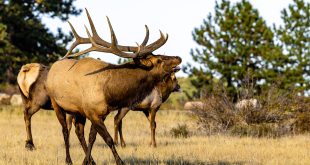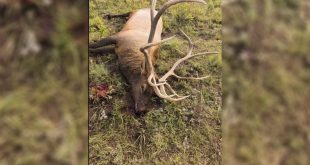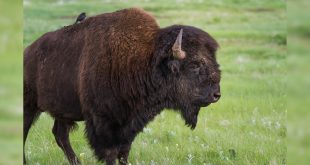That’s right, $123,241 dollars funded by sportsmen to be precise. The other 250K (roughly) for the research/project was Federally funded. Over the course of several months IDFG (Idaho Dept. of Fish and Game) tested methods for decreasing elk depredation on crop lands across southern Idaho. During this time, IDFG staff/employees shot 206 elk, often during the night using “sharpshooting” as their primary method of dispatch.
Once the animals were shot, they were then field dressed and hauled to a freezer and eventually taken to be processed and donated to charity. After word hit social media, sportsmen and women from all over the country were up in arms asking questions such as: Why didn’t we get an opportunity to help, or why are we spending money on “research” for elk depredation issues on land that we can’t even hunt?
After being bombarded with questions IDFG released a statement on the situation. No matter how you slice it, things are sticky on this topic, but it’s not all bad. Let’s start with elk populations that are over objective and primarily living on and destroying private land crops, which subsequently get State funded reimbursements for the damage… that’s right, State funded reimbursements. Which is another way of saying hunter funded reimbursements.
The Magic Valley region of southern Idaho cost IDFG (Sportsmen) $1,598,720.00 in depredation payouts. Yep, you read that correctly, 1.5 MILLION dollars. As to be expected, this raises the hackles as well as questions. Especially when most private land is NOT open to hunting and in turn, we pay those same people with closed gates for damages caused by OUR publicly owned elk. At first glance this could really stir the pot, however, IDFG has a wildlife depredation claims policy which can be found in their handbook.
IDFG clearly outlines parameters and minimum requirements that must be met prior to funds being allocated. Some of which are; landowners must take ALL responsible steps to prevent or reduce damage to their property. This is accomplished by working with IDFG to resolve the issues BEFORE crops or property are damaged. Additionally, the landowner must provide “reasonable public access” for hunting before and or as a resolution to the issue. The entire handbook outlines the roles and responsibilities, but at least we see an attempt to give the money to people that must be willing to work with hunters, which is a major prerequisite in my opinion. So, before we get all worked up thinking it’s unregulated free handouts, take some comfort in the policy behind it. Nonetheless, these are things that if left unchecked could become a major issue down the road. Especially if we the people don’t keep our hands in the mix.
Bottom line: these high dollar payouts to private landowners have prompted IDFG to investigate other processes in which they can reduce depredation caused by large ungulates, especially elk, deer and sometimes moose. Thus, IDFG decided to embark on a collaborative research study with “a University of Idaho graduate student” and test methods to help prevent or lessen the damages caused by elk predation on croplands. Whether it was completely necessary or not, IDFG stated that many of the elk were shot at night, thus the need to keep the job in house, and not open the opportunity to the public. Not that I completely disagree, but that is a hard line to draw in the sand. In addition to sharpshooting, IDFG tested the use of dogs, special fencing and spraying deterrents on crops. Results of this study will be available online at the IDFG website this coming spring/summer.
 Eastmans' Official Blog | Mule Deer, Antelope, Elk Hunting and Bowhunting Magazine | Eastmans' Hunting Journals
Eastmans' Official Blog | Mule Deer, Antelope, Elk Hunting and Bowhunting Magazine | Eastmans' Hunting Journals






If it helps the farmer I am for it. A much greater need in ID is controlling wolves and wild horses in the state which affects Elk.
Guy,
It would be interesting to know if any of the landowners here participate in Idaho’s “Access Yes!” in addition to receiving government funded sharp-shooting and depredation payments. I completely respect the rights of landowners to deny access to hunters or anyone else, period. However, that position should have consequences when it comes to getting any public funding or assistance relating to wild game issues, or for that matter improvements to an owner’s land.
Do you see any benefit to diverting IDFG revenue generated by sportsmen and sportswomen to landowners that refuse to grant access to hunters? On that assumption, this seems like a win for unsharing Idaho landowners (who have a somewhat infamous reputation for being stingy with access) and a loss for sportsmen and sportswomen. So, the bottom line seems to be, stingy Idaho landowners can have their cake and eat it to. Absolutely no land access to hunters and receive government payments paid for by the very group landowners refuse access to. Why would any landowner in Idaho feel the need to enroll in Access Yes! when they’re going to get paid by the state anyways, and with revenue generated from hunting/fishing licenses to boot? It seems like Utah’s CWMU program is a good model to follow here.
If I was an Idaho landowner, I’d be laughing all the way to the bank to cash that IDFG check.
Thanks.
Aaron
Sorry, meant to address Jordan, not Guy.
I guide around this area, and believe me when I say the IDFG office around here is pretty corrupt. They gave out OTC tags in alot of these areas to help with this issue. And when I say gave out I mean by the thousands, with very low success rates. The elk just ran to the forest service boundary or became nocturnal, hence why they were hunting them at night. It’s wrong on all kinds of levels. They also had some wasted meat that they turned into the butcher. And that really gets me. If that would’ve been from an outfitter or even just a hunter we would’ve been fined, as well as possibly our licenses revoke . But IDFG can get away with it? The whole thing is corrupt and a way to take our dollars out of our hands. I asked about elk numbers and herd density at a meeting last year, and was told that they didn’t have a count on the animals in the south hills zone. The regional director sat in front of a room of 100+ hunters, outfitters, and ranchers and told everyone that the elk were too spread out???? Blew my mind I thought that’s what you wanted.
My information is that the majority (172) of these elk were taken from one 40,000 acre ranch over the course of several months. The sticky point (I was not aware of the OTC tags mentioned above, very interesting). This 40,000 acre ranch is “organic” and that designation allows the owner to deny hunter access or something. to me that sounds like a loophole to help collect depredation funds- but what do i know? I do know know that the previous year this landowner was able to yoink the majority of the states depredation funds ($1.2 mil) via this technique. To avoid that happening again, F&G whacked the elk this year in an attempt to find out if night-sniping would keep the elk off the farm- doesn’t seem like it did. Saved some $, and now there’s a cap in place for depredation payouts- but it will be interesting to see how this develops. Bottom line is that hunters should be the ones whacking these elk. They’ll even pay to do it.